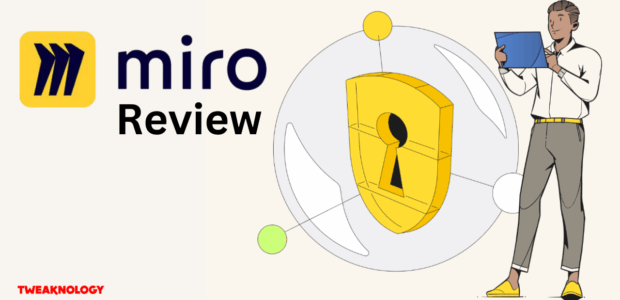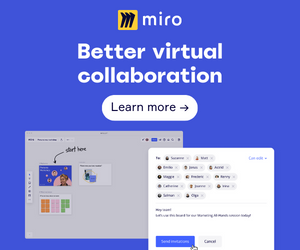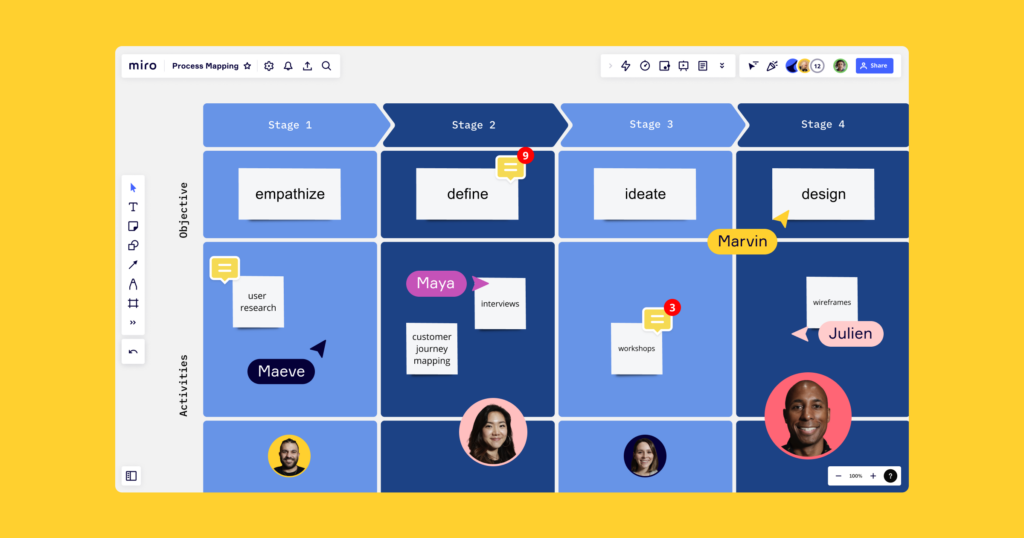
In the realm of collaborative tools and digital whiteboards, Miro has emerged as a prominent player, offering a versatile platform for teams to collaborate, brainstorm, and organize ideas visually. With its wide array of features and user-friendly interface, Miro has garnered a significant following among businesses, educational institutions, and creative teams. In this comprehensive review, we will delve deep into Miro's capabilities, exploring its strengths, weaknesses, and suitability for various use cases.
Getting Started with Miro
Miro's Onboarding Experience
Miro's journey begins with a remarkably user-friendly onboarding process. Signing up for an account is straightforward, and Miro offers a range of options, including Google, Slack, and Microsoft accounts, making it convenient for users to integrate with their existing digital ecosystem.
Upon logging in, users are greeted with an intuitive tutorial that guides them through Miro's basic functions. This initial walkthrough is clear, concise, and ensures that even first-time users can quickly grasp the fundamentals.
The User Interface
Miro's interface is clean, well-organized, and visually appealing. The canvas serves as the central workspace, where users can create boards for various purposes. The toolbar on the left provides easy access to essential tools and elements, while the right sidebar houses additional functionalities, such as the ability to add collaborators, chat, and access board settings.
The UI's simplicity makes it accessible to users with varying levels of technical proficiency. However, it doesn't sacrifice depth for simplicity, as Miro offers advanced features and customization options for those who require them.
Collaboration and Teamwork
Real-Time Collaboration
One of Miro's standout features is its robust real-time collaboration capabilities. Multiple team members can work on the same board simultaneously, allowing for seamless brainstorming and idea sharing, regardless of geographic location. This is especially valuable in today's globalized work environment, where remote and distributed teams have become the norm.
Collaborators can see each other's cursors and edits in real-time, enhancing the feeling of working together in a physical space. Moreover, Miro provides a variety of built-in communication tools, such as comments, chat, and @mentions, to facilitate discussions within the platform. This minimizes the need for external communication tools, streamlining the workflow.
Templates and Frameworks
Miro offers an extensive library of templates and frameworks tailored to different use cases. From Kanban boards and mind maps to product roadmaps and user personas, these templates help jumpstart projects and save time on the initial setup. Users can customize templates to suit their specific needs, making them a valuable resource for both beginners and experienced Miro users.
Interactive Elements
Miro goes beyond traditional digital whiteboards by offering a rich set of interactive elements. Users can add sticky notes, shapes, text, images, and even embed external content like videos and web pages. These interactive elements make boards more engaging and facilitate dynamic discussions and idea generation.
Design and Customization
Customizable Boards
Miro allows users to customize boards extensively, giving them the flexibility to adapt the workspace to their unique requirements. Users can change the background, adjust the grid, and define templates for consistency across boards. This level of customization is particularly useful for design teams, as it enables them to create visually appealing and functional boards that align with their creative processes.
Styling Options
The platform offers a range of styling options for elements, allowing users to apply colors, fonts, and formatting to create visually appealing content. This is essential for users who want to convey information in a clear and aesthetically pleasing manner. The ability to group and align elements further enhances the design capabilities, making it easier to create organized and professional-looking boards.
Integrations
Miro's integration capabilities are another strong suit. It seamlessly integrates with popular tools such as Slack, Microsoft Teams, Google Drive, and more. This integration ensures that users can connect Miro to their existing workflow, making it an integral part of their daily operations. The ability to embed Miro boards directly into other platforms simplifies collaboration and accessibility.
Productivity and Workflow
Task Management
Miro enhances productivity by offering built-in task management features. Users can create tasks, assign them to team members, set due dates, and track progress directly within the platform. This eliminates the need for external task management tools, reducing the complexity of managing projects across multiple applications.
Automations
To further streamline workflows, Miro offers automation features through integrations with platforms like Zapier. These automations allow users to create triggers and actions based on specific events within Miro. For instance, automatically generating tasks in a project management tool when a board reaches a certain milestone can save valuable time and reduce manual data entry.
Version History
Miro's version history feature is a valuable asset for teams working on iterative projects. It allows users to review changes made to a board over time, revert to previous versions, and understand the evolution of ideas. This feature promotes transparency and accountability within teams, as users can see who made each change and when.
Accessibility and Cross-Platform Compatibility
Accessibility
Miro places a strong emphasis on accessibility, making the platform usable for individuals with disabilities. It complies with Web Content Accessibility Guidelines (WCAG) standards, ensuring that it is navigable and functional for people with visual impairments and other disabilities. This commitment to accessibility is commendable and aligns with the principles of inclusive design.
Cross-Platform Compatibility
Miro's versatility extends to cross-platform compatibility. It is available as a web application, desktop application (Windows and macOS), and mobile app (iOS and Android). This multi-platform support ensures that users can access and collaborate on boards from their preferred devices, enhancing the platform's usability and reach.
Pricing and Plans
Miro offers a range of pricing plans to accommodate different needs and budgets. The plans include:
- Free Plan: The free plan provides essential features and is suitable for small teams and individual users. It allows for an unlimited number of team members to view boards, but limits the number of editors and boards that can be created.
- Team Plan: The Team plan is designed for small to medium-sized teams and offers a wider range of features, including unlimited editors, advanced integrations, and templates. It is priced per user per month, making it scalable for growing organizations.
- Business Plan: The Business plan is tailored for larger organizations with advanced security and collaboration needs. It includes features such as single sign-on (SSO), enhanced access controls, and dedicated customer support.
- Enterprise Plan: The Enterprise plan is a customizable option for organizations with specific requirements, including advanced security, compliance, and custom solutions. Pricing is available upon request.
While Miro's free plan is attractive for individuals and small teams, it's worth noting that many of the advanced features and integrations are available only in the paid plans. Organizations with complex collaboration and security needs may find the Business and Enterprise plans more suitable.
Security and Privacy
Security Features
Miro places a strong emphasis on security, which is crucial for organizations handling sensitive data and intellectual property. Some of the notable security features and practices include:
- Data encryption in transit and at rest to protect user information.
- Role-based access controls to manage user permissions effectively.
- Compliance with industry standards such as SOC 2 and GDPR.
- Single sign-on (SSO) for enhanced authentication and access control.
- The ability to revoke access to boards and data at any time.
These security measures help ensure that Miro is a safe platform for collaboration, even in industries with strict compliance requirements.
Privacy
Miro also prioritizes user privacy by providing clear and transparent privacy policies. Users have control over their data and can delete their accounts and associated data at any time. Additionally, Miro adheres to data protection regulations and allows users to export their data for compliance purposes.
Customer Support and Community
Customer Support
Miro offers various customer support channels to assist users. These include email support, a comprehensive knowledge base, video tutorials, and webinars. The availability of different support options ensures that users can find answers to their questions and receive assistance when needed.
Community
Miro has cultivated an active and engaged user community. Users can join forums, participate in discussions, and share their experiences and tips with fellow Miro enthusiasts. This community-driven approach fosters a sense of belonging and helps users learn from one another.
Limitations and Areas for Improvement
While Miro boasts a wide range of features and benefits, it is not without its limitations and areas for improvement:
- Learning Curve: Despite its user-friendly design, some users may still find Miro's extensive feature set a bit overwhelming at first. Additional guidance and onboarding resources could help users make the most of the platform more quickly.
- Price: While the free plan is enticing, some of the most advanced features are reserved for paid plans, which may not be affordable for all users or organizations, particularly small businesses and startups.
- Offline Access: Miro primarily operates as a cloud-based platform, which means it requires an internet connection to function. The availability of offline access or a desktop version that works offline could benefit users in areas with unreliable connectivity.
- Mobile Experience: While Miro has a mobile app, the mobile experience may not be as feature-rich or intuitive as the web or desktop versions. Improvements in the mobile app's capabilities and user interface could enhance usability for on-the-go users.
- Exporting and Printing: Some users have reported limitations when exporting or printing large boards. Enhancements in this area could improve the platform's usability for users who need physical copies of their boards.
Conclusion
Miro is undeniably a powerful and versatile platform for visual collaboration and brainstorming. Its user-friendly interface, real-time collaboration features, extensive template library, and integration capabilities make it a valuable tool for teams across various industries.
While it excels in many areas, it's essential to consider your specific needs and budget when choosing a collaboration tool. Miro's pricing plans, while reasonable, may not be accessible to all users. Additionally, the learning curve for new users, especially those unfamiliar with digital whiteboards, should be taken into account.
Overall, Miro has earned its place as a leading digital whiteboard and collaboration platform, and its commitment to security, accessibility, and user privacy demonstrates its dedication to creating a valuable and inclusive product. Whether you're part of a remote team, a creative agency, or an educational institution, Miro has the potential to transform the way you collaborate and bring your ideas to life.




